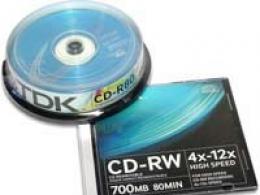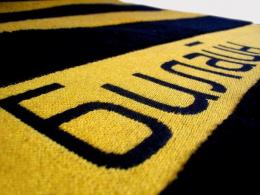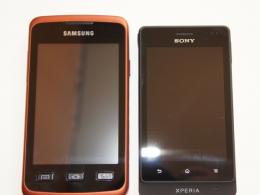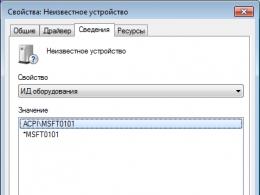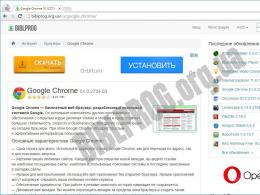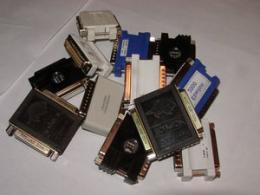Restoring the system partition of the Rikor TV receiver. Restoring the system partition of the Rikor TV receiver Updating the Rikor receiver
RESTORING THE SYSTEM PARTITION OF THE RICOR TV RECEIVER
In the case when the software ( software) does not function correctly or does not load, you can restore the system software partition on your hard drive. To do this, follow these steps:
1. Turn on the RICOR TV satellite receiver.
2. When any indicator on the front panel lights up, press and hold any button on the remote control (for example, OK), pointing the remote control at the RICOR TV satellite receiver.
3. After 10 seconds, release the button.
4. Press the same button 3-4 times at 1 second intervals.
If the window "" for 2-3 min. didn't open, then turn off the RICOR TV satellite receiver and repeat the steps 1- 4 .
If the window " Restoring a system partition on a hard drive" opens, then follow these steps.
- ▪ To restore the system partition, press the remote control button.
- ▪ To restore the system partition without deleting video recordings, press the remote control button.
- ▪ Close the “Recovering system partition on hard drive” dialog box (it was opened incorrectly or it is necessary to postpone the recovery process) by pressing any other button on the remote control.
The process of restoring the system software partition is accompanied by necessary messages. Do not turn off the power until the system partition recovery process is complete. satellite receiver RIKOR TV!

After successful recovery of the satellite receiver, RICOR TV will automatically reboot.
Attention! After restoring the system partition, all user data (profile, archive, PC) and RICOR TV settings, as well as the Internet connection and GPRS modem settings are deleted. The receiver firmware version returns to the state at the time of purchase of the RICOR TV receiver.
Before To restore the system partition, you must perform the following steps.
- ▪ Turn off the RICOR TV satellite receiver.
- ▪ Insert the Ricorov SIM card into the GSM module slot (if a non-Rikorov card is installed in it).
- ▪ Turn on the RICOR TV receiver and open the GPRS connection setup window.
Write the code value in the code line.
After To restore the system partition, you must perform the following steps.
- ▪ Update the firmware of the RICOR TV receiver to the current version by selecting the main menu item Settings > Software Update.
- ▪ Restore GPRS connection. To do this, open the GPRS connection settings window and enter the previously saved code value into the code line.
RICOR developers are constantly improving the firmware of receivers, so they are regularly updated. Official firmware is updated directly off the air. But the best part is that it is not always possible to introduce official releases of firmware updates. The reasons for such behavior by the vendor are, as a rule, purely legal.
Unofficial firmware files for receivers RICOR TV (Active TV) are situated in file storage on our website
For manual update firmware for the Rikor receiver, you need to create a flash drive. A very small (512 MB) media is quite enough. Files with unofficial RICOR firmware are copied to the root of a flash drive formatted in FAT 32 (it is also possible in Ext2 and Ext3 formats, but this is via Linux, which is fraught with a lot of difficulties for a non-professional in this OS).
The USB keyboard will have to be disabled. After flashing the firmware, you can connect it again
The prepared flash drive must be inserted into the connector on the rear panel, enter Main OSD menu and select menu Software Update.By the way, there is some inconvenience with USB connectors on the rear panel can be greatly reduced by inserting regular USB extension cables of the required size into these connectors and bringing the ends to a more convenient and accessible place.
Attention! The process of installing software updates ends with an automatic reboot of the receiver. As a result, all current recordings are interrupted! First, finish recording all the programs you want. And then calmly flash the RICOR receiver.
Buttons UP or DOWN select item on the remote control USB(prepared USB device must be inserted into the appropriate connector on the rear panel of the receiver).
Note: You can update to the official version via the Internet. IN unofficial firmware developers may insert some interesting features for some political reasons that are not included in the composition official updates Software for Active TV satellite receivers.

Press the remote control button OK to close the message.
▪ If there is a newer firmware version than the one already installed, a dialog box opens on the screen Software Update indicating new version Software available for installation.
- Click the button Update to start the installation process of a new software version.
If there are no updates available, the user receives the message: " You have installed latest version BY".
- Click the window button Exit or remote control button EXIT to close this window without installing updates.

When you press the button Update The process of downloading and installing update packages on the receiver begins. The update installation process is displayed on the screen using an indicator.
Attention! Never turn off the power to the receiver before complete completion the process of installing firmware updates! After the update installation process is completed, a window appears on the screen with the message: “The updates have been installed successfully. The IVR will automatically reboot in 10 seconds.”
1- Power on indicator
2 - Indication of recording to hard disk
3 — Indication of operating mode (LED is on when standby mode is off)
4 - IR receiver reception area

*
The IVR 5100S model differs from the IVR 5250S model in the layout of the component units and
power on/off method (page 12).
A unique receiver that can: rewind live broadcast, pause live broadcast for up to 10 hours, store a large amount of information (250Gb, ~ 220 hours of video), record video from 5 channels simultaneously, compatible with high definition HD format
RICOR TV This is “Personal Television”, truly convenient for the viewer, which combines the capabilities of TV and computer.
Now you have the opportunity to watch your favorite programs and movies on air at a time convenient for you, as many times as you like. You can create your own TV channel and your news, which will show exactly what interests you.
An excellent domestic receiver with HDTV support for Rikor TV.
Design and connections
The first thing that attracts attention in the presented new product is its durable, even somewhat heavy for a household receiver, silver-colored body. The impressive dimensions of the device (440x290x75 mm) give the device a solid appearance. The chassis and housing cover of the IVR 5250 terminal are made of metal with a thickness of about 1 mm.
So we can say with confidence: without any deformation, the terminal will “feel” calm if you put a couple of other home multimedia devices weighing several kilograms on it. We were able to verify this during testing. Despite such a “military” safety margin, the terminal looks quite stylish and modern. The appearance of the front panel of the receiver corresponds to the general design concept, which is characterized by significance and conciseness. There are no device control buttons on the front panel. Operating modes are indicated by three blue dot LEDs:
- power indicator;
- HDD recording indicator;
- viewing/standby indicator.

On the left side wall of the receiver there is a power switch. He is unusual. A touch contact is used to turn on the device's power. In working mode the site touch sensor Illuminated by a blue LED.
On the right side wall of the case there are two slots for smart cards of the built-in conditional access system and a slot for installing a DVB-CI module.
On the rear panel of the Rikor IVR 5250 receiver there are:
- inputs of two DVB-S/S2 tuners LNB A and LNB B, equipped with F-type sockets. Each of the tuners has a loop output;
- EuroScart connector;
- HDMI digital multimedia video/audio interface connector;
- S-Video output (mini-DIN);
- RJ-45 connector Ethernet interface(LAN);
- RCA stereo audio outputs R/L;
- coaxial RCA digital audio output S/PDIF;
- RF modulator output for connecting a TV via high frequency RF OUT;
- transit input of the RF modulator RF IN;
- connector for connecting the GSM module antenna. The terminal kit includes a compact GSM antenna that is installed directly on the existing connector;
- connector for SIM card GSM module. The receiver kit includes a SIM card designed to support interactive services using the built-in GPRS modem;
- USB data port connector;
- power connector.
The set of interfaces available on the Rikor IVR 5250 receiver allows it to be classified as a group of subscriber devices equipped with multimedia functions. The absence of interfaces that make it possible to switch video and audio signals from other devices suggests a certain self-sufficiency of the product presented for testing. This decision by the developer, from our point of view, takes place since the demand for interface connectors, which are abundantly present in some devices, is usually low.
The layout of the receiver's electrical circuit is traditional: a system board and a board (more precisely, two boards) of the power supply. We were unable to determine the processor type. The radiator, glued to its upper surface, hid the markings, and we did not dare to remove it. On system board two identical DVB-S/S2 satellite tuners DNBU24511 Samsung are installed.
Receiver Rikor IVR 5250 equipped with a 3.5-inch HDD with a capacity of 250 GB (Seagate ST32508208CE). IN technical specification The terminal indicates that the product can be equipped with a hard drive with a capacity of more than 160 GB. Considering that for full support interactive features The device must be in active mode almost constantly; the developers have tried to alleviate the thermal conditions of the presented product. This is facilitated by placement electrical diagrams device in a fairly spacious case, equipped with a sufficient number of holes for convection, as well as additional forced cooling of the terminal power supply with a miniature fan.

In general, it has a design similar to the remote control of a digital satellite receiver, which has a device for recording and storing video information on a hard drive (PVR). Numeric keypad located at the top of the console. It can also be used to enter text. In the middle part of the remote control there are:
- buttons for working with OSD and cursor position control;
- digital video recorder mode control buttons;
- buttons for calling interactive services.
The remote control is small in size and fits comfortably in your hand. Function labels assigned to individual buttons are written in Russian or have a generally accepted international designation. For a user already familiar with digital satellite receivers, it will be somewhat unusual that the names of some functions differ from the generally accepted ones (for example, instead of EPG there is “IPP”). The purpose of the individual buttons does not correspond to what is indicated in the description of the receiver, although this does not create any special problems in operation.
A distinctive feature of the Rikor IVR 5250 receiver’s remote control is its “learnability”. Using this function, you can program selected buttons on the remote control so that you can use it to control, for example, a TV. The “learning” procedure is very simple and can be repeated by any user.
Possibilities:
- rewind live broadcast
- pauses live broadcast for up to 10 hours
- stores a large amount of information (250Gb, ~ 220 hours of video)
- records video from 5 channels simultaneously
- HD compatible
Technical data: satellite IVR 5250S, IVR 3100S
| Tuner | |
| Input connector: | Type “F”, IEC 169-24, socket |
| Input impedance: | 75 Ohm |
| Received frequency range | 950 - 2150 MHz |
| IF Bandwidth: | 36 MHz |
| Input level: | from - 65 to - 25 dBm |
| Standards support: | DVB-S and DVB-S2 |
| Maximum symbol rate: | 20-30 Msim/s (QPSK), 10-30 Msim/s (8PSK) |
| FEC support: | 1/2, 2/3, 3/4, 5/6 and 7/8 |
| Converter power supply (LNB): | +13 V (vertical polarization), +18 V (horizontal polarization) at currents up to 500 mA |
| Band switching: | tone 22+2 kHz |
| Protocol: | DiSEqC 2.0 |
| Number of tuners: | 2 |
| System Resources | |
| CPU: | STi 7100 |
| Flash memory: | 8 MB |
| System memory: | DDR SDRAM 128 MB |
| Video memory: | DDR SDRAM 64 MB |
| Hard disk capacity: | from 160 GB |
| Digital port | USB 2.0 |
| Software update: | OTA (“over-the-air”, via broadcast channels) |
| Video | |
| Video Decoding: | MPEG-2, H.264/AVC (MPEG-4) |
| Image Format: | 4:3, 14:9, 16:9 |
| Number of lines: | 1080i (High Definition HD),
576i (SD standard resolution) |
| Video outputs: | model IVR 5250S > TV SCART, S-Video, HDMI (digital) RF modulator ( factory setting): channel 36, frequency 591, 25 MHz |
| Audio | |
| Audio Decoding: | MPEG-1, MPEG-2 |
| Audio output: | model IVR 5250S > RCA stereo (analog), S/PDIF coaxial (digital D-audio) |
| Conditional Access | |
| model IVR 5250S | card reader: 2 connectors; CI interface: 1 connector |
| network hardware | |
| 100 Mbit Ethernet: | RJ-45 socket |
| GSM/GPRS module | |
| Power supply | |
| Voltage: | 90-260 V / 50-60 Hz |
| Power consumption: | no more than 75 W |
| Working temperature | 0 – 70 °C |
| Storage temperature | -20 – 70 °С |
| Permissible relative humidity Working: |
85% |
| Storage: | 90% |
| Dimensions (W x H x D), mm | model IVR 5250S > 437 x 73.6* x 288 / * size with legs / |
| Weight, kg | model IVR 5250S > 4.65 |
| List of supplied equipment: | IVR, SCART-SCART cable, power cable, remote control, jumper cable, GPRS antenna |

